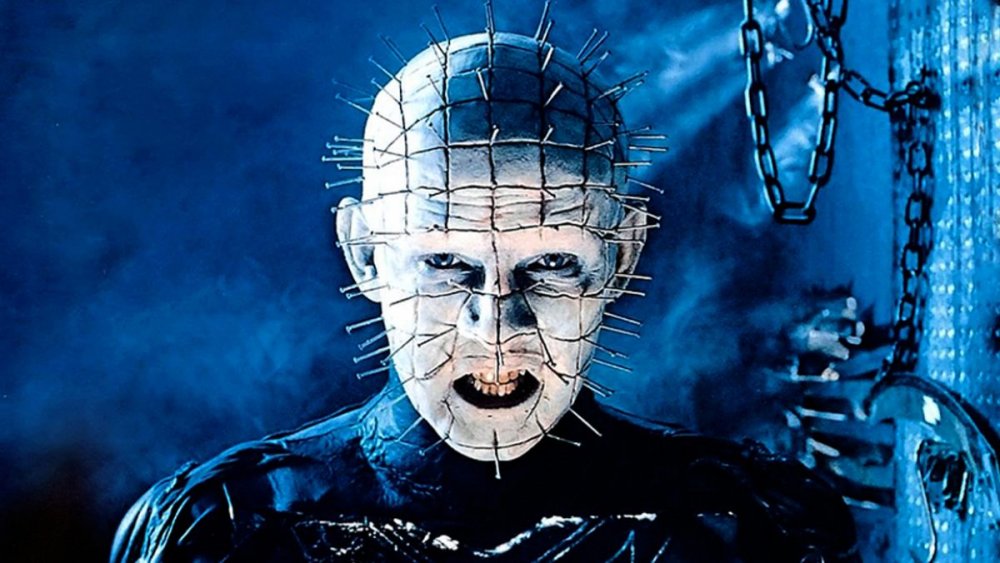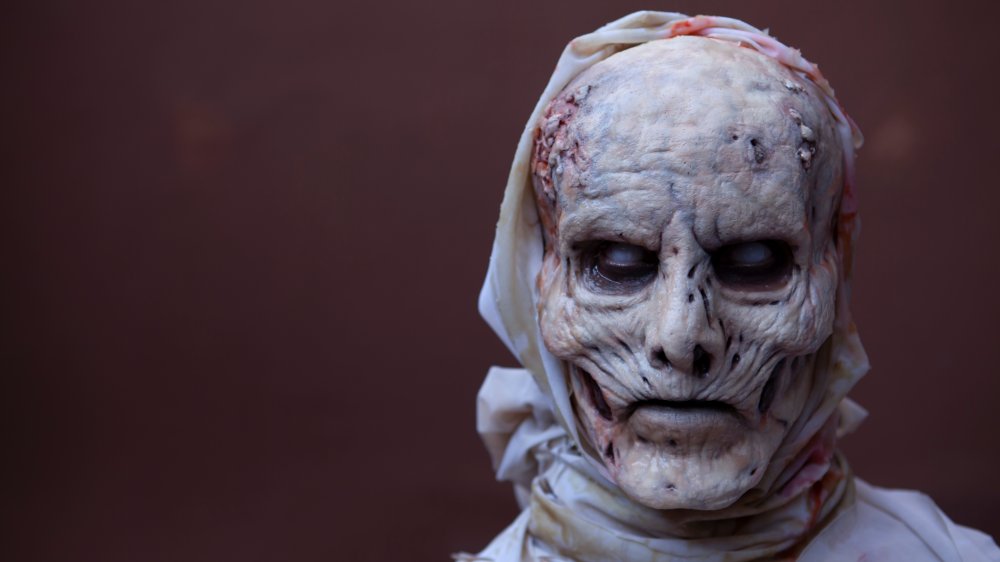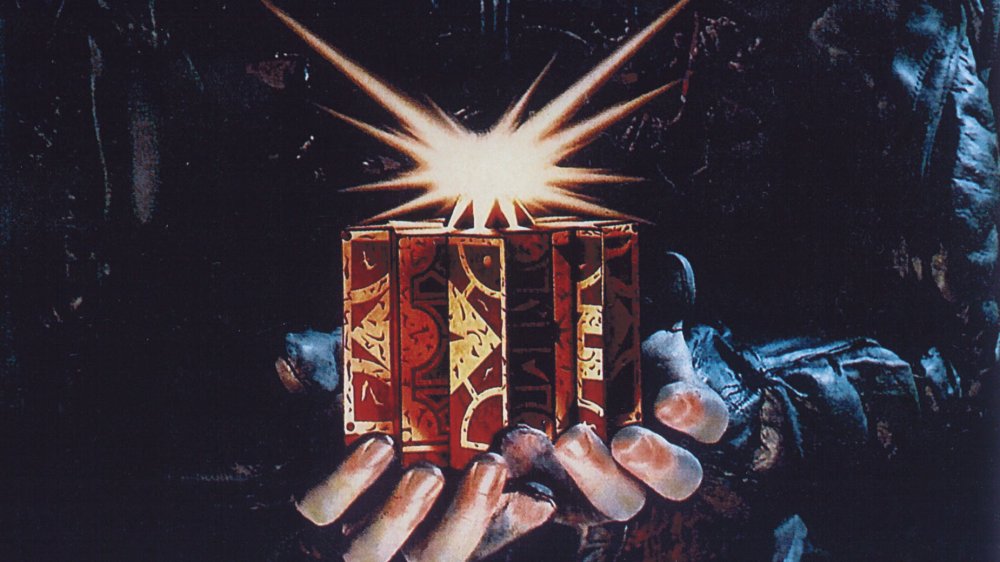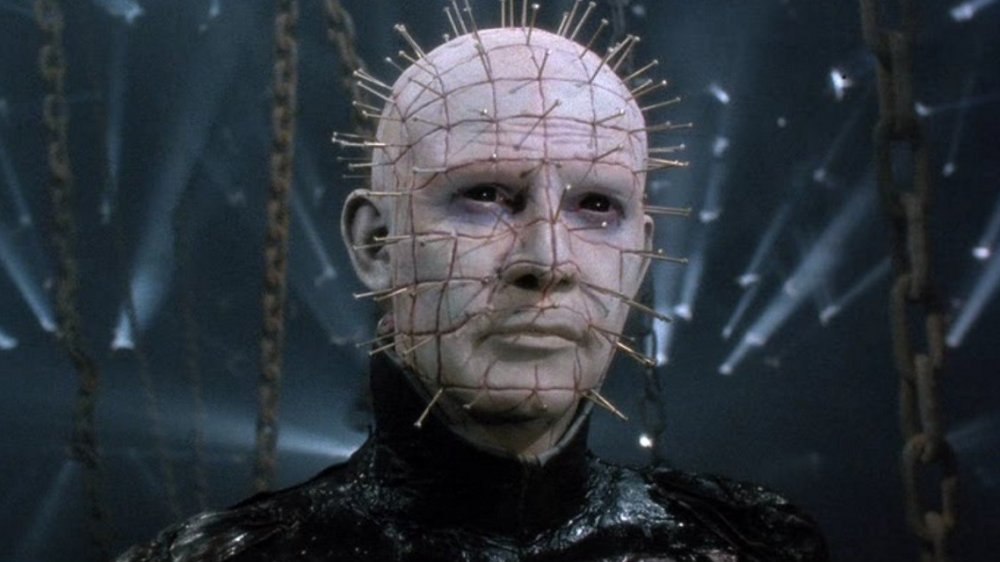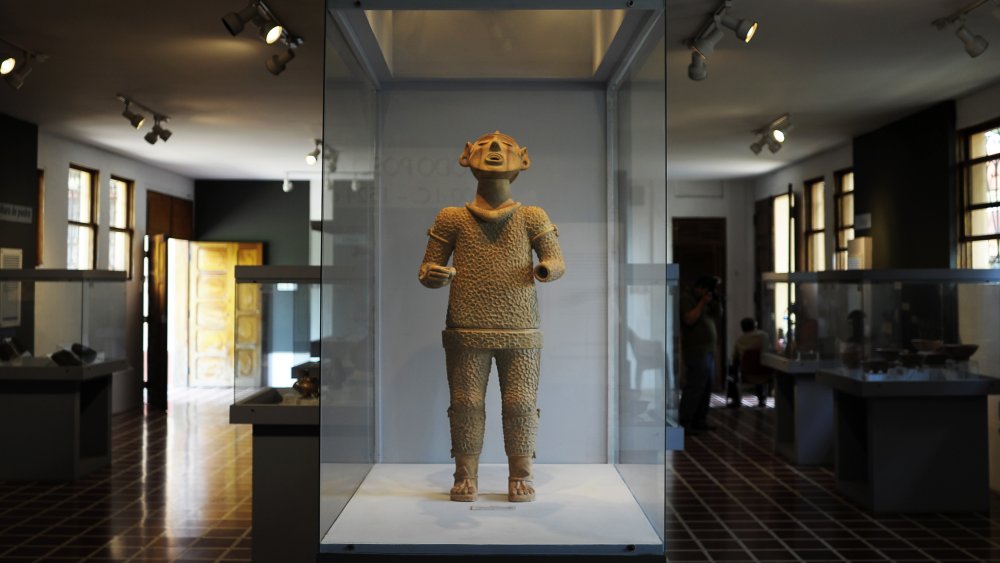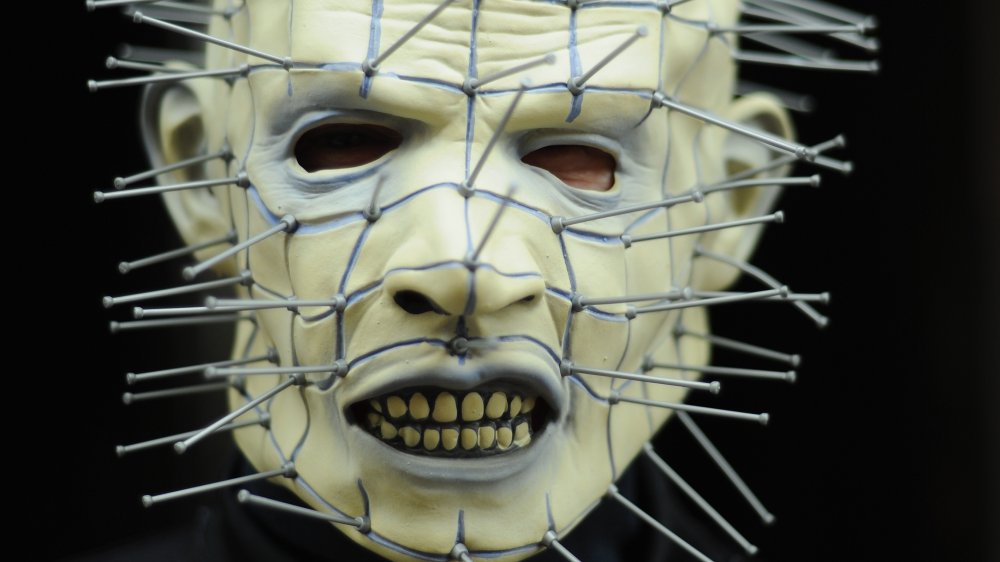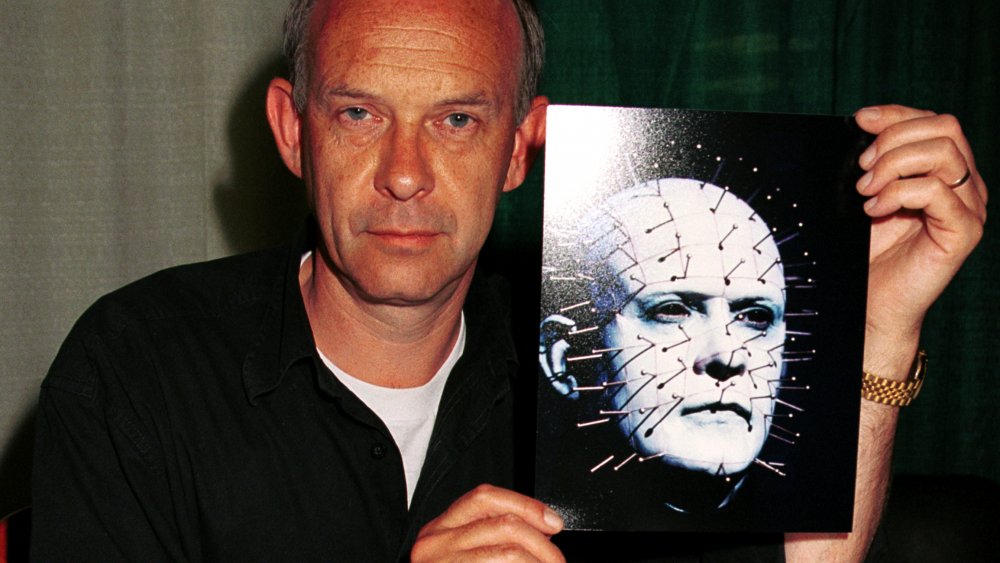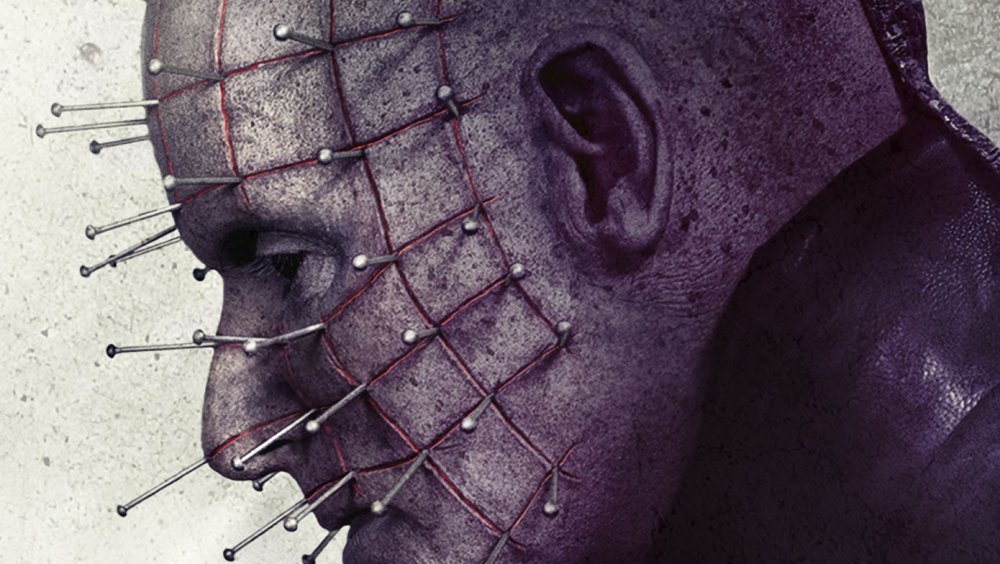Pinhead's Entire Backstory Explained
Hellraiser had no right to build such a rich universe. The English horror flick, written and directed by scare-master Clive Barker, is a campy and grotesque exploration of sadomasochism. The first film, in fact, is built entirely around Julia Cotton's obsession with an affair she had with her husband's dead brother, Frank. Their late-night liaisons were so memorable, she is willing to sacrifice her husband to demons, in order to bring Frank back, piece by piece. Moreover, Hellraiser spends much more time lingering on the goopy, half-dead body of the semi-revived Frank Cotton than on the franchise's monster, the now-iconic Pinhead. Believe it or not, Pinhead isn't even named in the film, and those who remember the first film well will recall that he plays a background role to the murderous psychosexual drama at the movie's fore. Regardless, he's become a touchstone of cinematic horror.
It took further films to flesh out Pinhead, much as Hellraiser pieced together Frank Cotton's body. Across ten Hellraiser films, the most beloved cenobite of all has actually developed a deep backstory worthy of his striking design. This is his story in its gruesome entirety.
Understanding Cenobites
The first thing you need to know about Pinhead is that he's a Cenobite. This race of extra-dimensional creatures are characterized by their extensive mutilation, obsession with sadomasochism, and bloodthirsty ways. Though their individual predilections differ, the Cenobites are united by an interest in ritual torture and death. Anyone unlucky enough to unlock their dimension is subject to any number of outlandish punishments. It's heavily implied that many of the Cenobites were humans with extreme appetites before being transported into the Hell dimension by opening their cursed puzzle box — these unlucky souls now serve as members of The Order of The Gash. The novella that serves as the basis of the first Hellraiser movie describes the Cenobites as " sexless things with ... corrugated flesh." Now that's attractive.
We learn in the first two sequels, Hellbound: Hellraiser II and Hellraiser III: Hell on Earth, that Pinhead himself was drawn to the box that serves as a key to the Hell dimension while testing his limits for pain. The very first scene of the series shows a similarly adventurous Frank Cotton being torn to shreds by meat hooks after discovering the Hell dimension box on a trip to Morocco. Of course, Frank makes an attempt to come back to our world, while Pinhead gets quite cozy as the leader of the Cenobites.
Those puzzling boxes
It might not surprise you to learn that the backstory of the box that leads to Pinhead's world is nearly as detailed as the creature's own origin myth. The so-called Lament Configuration is a puzzle box created by architect, mass murderer and all-around pervert Philip LeMarchand. When he wasn't creating intricate cathedrals or killing indiscriminately, the French artisan would build puzzle boxes meant to reveal deeply held secrets or satisfy dark desires for anyone who could solve them.
The Lament Configuration is just one such box, created while LeMarchand was working as a toymaker. He made the box for a rich duke with a penchant for murder and an extreme interest in occult practices. The box plays a more and more complex tune to let players know they are getting closer to solving the puzzle, ultimately killing them when the Cenobites are set free to enact their elaborate tortures. As The Hellbound Heart puts it, "LeMarchand, who had been in his time a maker of singing birds, had constructed the box so that opening it tripped a musical mechanism, which began to tinkle a short rondo of sublime banality ... Each segment presented a fresh challenge to fingers and mind, the victories rewarded with a further filigree added to the tune."
He was once a man
So who exactly is Pinhead? Where did he come from? How did he come to dwell in Hell? The second and third movies in the series dive into Pinhead's backstory, revealing that he was once a British soldier who served in World War 1.
Pinhead's human origins are first indicated in Hellbound: Hellraiser II, when an old photograph forces Pinhead to remember his former life. Prior to his time in the Hell dimension, the monster was a Victorian-era Brit named Elliot Spencer who took up arms in service to his country, only to have his faith in humanity shaken during the Battles of Flanders.
Doug Bradley, who played Pinhead in many of the Hellraiser films, once explained how Spencer went from a charismatic leader of men to someone seeking out the kind of pain doled out by the Cenobites. Bradley recalled watching a documentary about the Battle of the Somme, and how he was struck by "[a soldier] talking about all his comrades who had died on the first day of the Battle of the Somme — something like 60,000 British troops were killed or injured in the first 24 hours. He felt as though he had cheated, that he shouldn't have lived, that ... he should have been buried along with his comrades in France. And I thought that's exactly Elliot's thing. That's exactly what leads him from there to this."
Trapped by the box
Pinhead's story grows far more fleshed out in Hellraiser III: Hell On Earth. This installment spends much of its time exploring human misery and war. Naturally, Pinhead shares how he felt as a human soldier, watching so many of his fellow countrymen perish on the front lines. In a monologue about the lasting effect of the war on the men of the early 1900s, Pinhead plainly states that his disrupted faith in people and God led him to experiment with torture: "We'd seen God fail us; so many dead. For us, He too fell at Flanders. The war destroyed my generation. Those that didn't die drank themselves to death ... I went further. I was an explorer of forbidden pleasures. Opening the box was my final act of exploration — of discovery."
According to Pinhead, the underlying sound of human history is the noise of a blade meeting skin. "The suffering of strangers, the agony of friends," he muses, "[the sound is] a secret song at the center of the world." Pain, to Pinhead, is truth — all else is noise. The degradation of war is the final discovery, the endpoint of civilization, the only real thing in a world full of falsehoods. Everyone will figure it out, in the end — he just got there a little faster.
An Aztec god?
The story of what Pinhead the Cenobite actually is can get a little muddled. The first two films show him as a nameless demon, then a converted human on a quest to inflict pain. During that second film, however, Elliot Spencer is revived in human form and murdered. What's left behind is the most craven, base, and evil impulses in Spencer's personality, which reconstitute into Pinhead.
The 1993 Pinhead comic series goes to the heart of the question of what makes up Pinhead a little differently. A mini-series devoted to the monster's past, it claims that Pinhead is merely the latest reincarnation of an ancient deity. Pinhead is, in fact, the newest face of the Aztec god Xipe Totec. While Xipe Totec was an agricultural god associated with the regular rebirth of seasons, he also ritually flayed himself to feed humanity. He could even peel off his skin entirely and reveal a golden body underneath. His followers believed that Totec invented the concept of war and desired human sacrifices, much the way the Cenobites constantly need new humans to torture.
Priestly aspirations
Clive Barker himself has made the religious elements of Pinhead's story explicit. If naming their dimension Hell and having Pinhead deliver a treatise against God wasn't enough, several of the movies refer to him as a priest and leader of the Cenobites. "That character is a priest of Hell," Barker said in an interview, "In [Hellraiser III], he's actually called on screen the Pope of Hell, which I guess came about later in the scripts."
Pinhead himself is a little more humble about the whole thing, calling himself an explorer "in the further regions of experience." He does admit, however, to encouraging holy connotations and says that depending on temperament, people view the Cenobites as angels or demons.
If Barker had his way, the character would be known as a leader of Hell first and a guy with pins sticking out of his face last. "In my original script, [Pinhead] didn't even have a name. Pinhead was the name that the special effects guy used actually. I was like 'Wait a second, you just named my villain Pinhead?' because I didn't think that sounded very dignified. But it ended up on the call sheet, and it just stuck."
He's pierced everywhere
Barker might be the Hellraiser series' mastermind, but that doesn't mean he's always gotten his way. In an interview, in fact, he revealed that he wanted to show Pinhead had piercings all over his body, only to be rebuffed. In a cheeky move that likely would have sucked some of the terror out of the original film, Barker had planned "to do a 'reveal' that Pinhead had a piercing below the navel, but somehow wanted to be discreet about it. Just something that indicated he had genital piercings." This did not, as fans know, pan out. It might have been for the best — can you think of a not-ridiculous way to indicate a character's southerly body modifications?
We have to wonder as well how his comics-only girlfriend Merkova felt about this. Unfortunately we can't ask, as she was run through with a broadsword and died in Pinhead's arms.
His own video game
2005's Hellraiser: Hellworld, the eighth installment of the Hellraiser franchise, put a 2000s twist on its story of interdimensional murder pervs. Hellraiser: Hellworld features a computer game based around the mythology of the Cenobites and Philip LeMarchand's notorious puzzle boxes. Though viewers are initially led to believe that attendees are being murdered by Pinhead at a themed party based around the video game, the film reveals that these are actually hallucinations. These human victims have, in fact, been drugged and buried alive. This intense punishment comes at the hands of the party's host, who wants to punish the people behind the Pinhead game after her gaming-addicted son commits suicide.
In a final twist, the host learns that her son came into possession of a real life LeMarchand box. The box opens and the real-life Pinhead orders his Cenobites to kill the host. Let that be a lesson: Leave the murdering to the master.
He's not in Hell anymore
2018's Hellraiser: Judgment found Pinhead tied up in a cosmic battle, revealing that God and Pinhead are, in fact, totally in cahoots. However, all is not well: Pinhead interferes with the plans of God and kills the angel Jophiel when the angel attempts to take his latest victim away. Because of Pinhead's actions, a serial murderer is killed in defiance of God's plan — The Almighty had hoped to use the murderer's actions as a tool to instill fear in the heart of sinners. Consumed with wrath, God punishes Pinhead in the only way he can: He withholds punishment.
Pinhead is, at his core, a seeker of pain. Moreover, he's a leader in Hell. God takes all that away from him by making him a mortal man. Putting him back on Earth and forcing him to live without his constant tortures is the cruelest thing one could do to the monster, and that's exactly how Hellraiser: Judgment leaves him. Alas, poor Pinhead. Who is he without pain?
